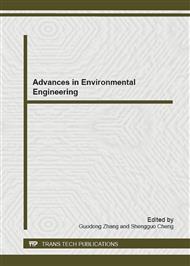p.295
p.299
p.305
p.309
p.313
p.318
p.322
p.326
p.331
Experimental Research on the Advanced Treatment of Coking Wastewater by Patented Wastewater Treatment Equipment
Abstract:
In this study, we presented an approach to coking wastewater advanced treatment process with a patented wastewater treatment equipment. The samples were collected from the effluents of the biological treatment tank in a coking wastewater treatment plant. With the experiments of four static single factors and the continuing dynamic process, the discussions about the effects of pH value, influent loading, reaction time, and volume ratio on chromaticity, COD and NH3-N respectively were conducted. The experimental results identified that the optimum process parameters were pH of 3, influent load of 1m3/m2•h, reaction time of 4h and volume ratio of 2:1 respectively. When influents of chromaticity, COD and NH3-N were 210 times, 249.4mg/L, and 31.7mg/L respectively , the effluent of chromaticity, COD and NH3-N were 16 times, 49.7mg/L, and 9.5mg/L respectively, these values could meet the National standard of Recycling and Miscellaneous usages of Municipal Sewage on chromaticity, COD and NH3-N requirements.
Info:
Periodical:
Pages:
313-317
Citation:
Online since:
November 2012
Authors:
Price:
Сopyright:
© 2012 Trans Tech Publications Ltd. All Rights Reserved
Share:
Citation:


